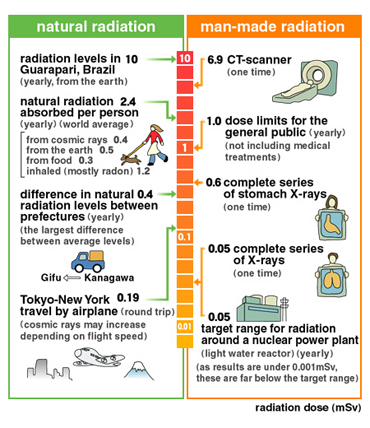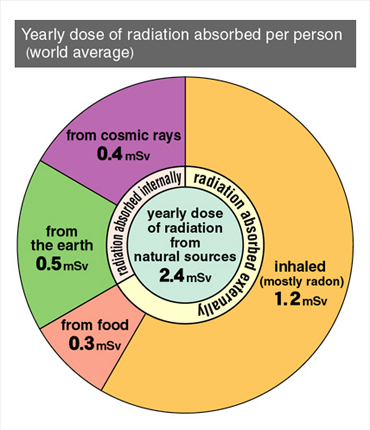 Is it true that you are exposed to radiation while on an airplane? What are other forms of so-called natural radiation? Is it true that you are exposed to radiation while on an airplane? What are other forms of so-called natural radiation?
 Radiation levels are indeed slightly higher on an airplane in flight than on the ground, but this is nothing to worry about. Natural radiation includes cosmic rays, radiation from the earth, radionuclides in the body, and radiation from naturally radioactive gases in the air. Radiation levels are indeed slightly higher on an airplane in flight than on the ground, but this is nothing to worry about. Natural radiation includes cosmic rays, radiation from the earth, radionuclides in the body, and radiation from naturally radioactive gases in the air.
Radiation dose from natural radioactivity
 |
Cosmic rays such as proton and alpha rays produce radiation that filters down to the earth’s surface. Upon entering the earth’s atmosphere, cosmic rays either react with atomic nuclei, generating secondary cosmic rays, or collide directly with atoms in the air, producing radioactive nuclides.
The intensity of cosmic rays doubles with every? 1,500 - 2,000 meter rise in altitude. Since airplanes fly at high altitude, exposure to cosmic rays is greater than on the ground. In an airplane flying at an altitude of 8,000 meters, the radiation dosage is around 2 - 3 micro-sievert per hour (a micro-sievert is a millionth of a sievert). At sea level in Japan, the total radiation dosage from cosmic rays over a full year is 0.26 milli-sievert. Meanwhile, the dosage on a single flight from Tokyo to New York at the international altitude of 10,000 meters is estimated at around 0.1 milli-sievert, and the dosage on a domestic flight at around 0.003 milli-sievert.
These quantities are considered insignificant.
In addition to cosmic rays, natural radiation includes radiation from the earth, radiation generated by radionuclides of potassium and carbon in the body, and radiation from the naturally radioactive gas radon which is present in the air. These combine to produce an effective annual dosage of 2.4 milli-sievert. Thus, we live and work in the midst of natural radiation every day of our lives.
Radiation in daily life
 |
Cheked by Kuniaki Hayashi M.D. Professor Nagasaki University Graduate School of Biomedical Sciences
Cheked by Yutaka Okumura Professor Nagasaki Atomic Bomb Disease Institute Nagasaki University Graduate School of Biomedical Sciences
Written by Makoto Ochi M.D. Associate Professor Nagasaki University School of Medicin
|

